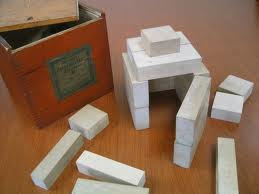Friedrich Froebal was a German education theorist who laid the foundation for modern education based on the recognition that children have unique needs and capabilities. He developed the concept of the “kindergarten”. Fröbel advocated the importance of free play in childhood. And created learning materials that was designed to be given to a child to provide material for the child's self-directed activity.

At the 1876 Centinnial Exhibition in Philadelphia Anna Lloyd Wright was attending the event and became fascinated with a demonstration of children playing with the Froebel materials, especially the blocks. Ms. Wright watched as the children created geometric forms and designs from small wooden blocks and thought that these blocks would be perfect for her son Frank.

Later in life Frank Lloyd Wright became one of America's most celebrated architects. And throughout his career Wright always credited the Froebel blocks as the greatest influence in forming his sense of design.

In his autobiography he cited the blocks indirectly in explaining that he learned the geometry of architecture in kindergarten play,[1] writing "For several years I sat at the little Kindergarten table-top . . . and played . . . with the cube, the sphere and the triangle—these smooth wooden maple blocks . . . All are in my fingers to this day . . ."
I wanted to share this story as a nod to our architecture theme, the value of play, the possibility of greatness, and as a tribute to our most valued possession, our block set.-Mr. Nick















































